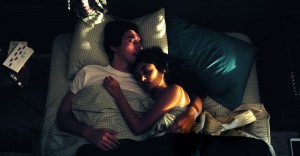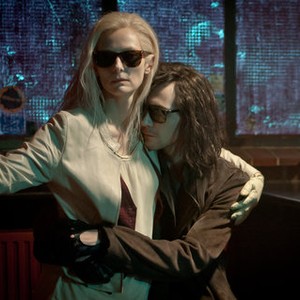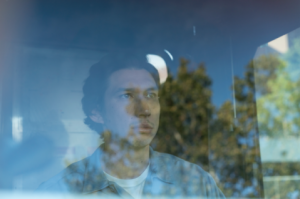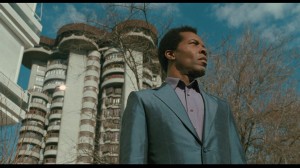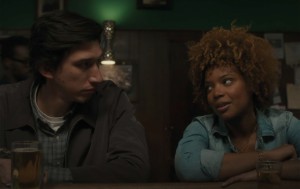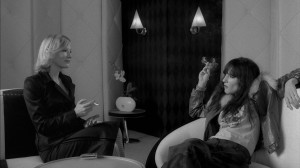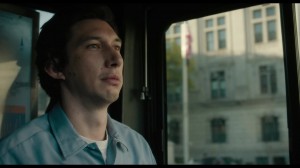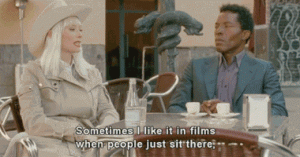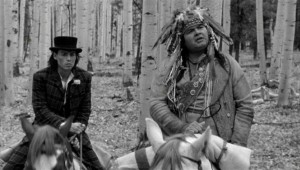Commissioned by the French quarterly Trafic for its 102nd issue (Summer 2017). — J.R.
1. Jarmusch as dialectician
For some time now, Jim Jarmusch has been operating as an
autocritical dialectician in his fictional features. Politically as
well as commercially, The Limits of Control offers a sharp
rebuke to his preceding film, Broken Flowers, by following
Bill Murray as a protagonist — a bored and diffident Don Juan
roaming across the United States to visit four of his former
lovers, in order to discover which one he impregnated with
a son — with Isaach de Bankolé as a protagonist, a hired
assassin in Europe pursuing Bill Murray in the role of Dick
Cheney as he hides out in a bunker until the assassin
finally strangles him with a guitar string. But even more
striking is the radical contrast between Jarmusch’s most
elitist feature (and in many ways my least favorite), Only
Lovers Left Alive, about a romantic, middle-aged married
couple played by Tilda Swinton and Tom Hiddleston —
vampires named Adam and Eve who evoke junkies, rock
stars, and Pre-Raphaelite artists, living on separate
continents in Tangier and Detroit — and Jarmusch’s
most populist feature (and one of my favorites),
Paterson, about a younger romantic couple living together
in Paterson, New Jersey, a bus driver named Paterson
(Adam Driver) who writes poetry in his spare time and a
housewife named Laura (Golshifteh Farahani) who cooks,
specializes in creating black and white décor and clothing,
and is learning to play the guitar.
The dialectical contrast between the last two films goes much
further than the above description implies. Each of the romantic
and mutually devoted married couples in these two films has
a stronger and more dominant partner — the wife (Swinton) in
Only Lovers Left Alive, the husband (Driver) in Paterson —
who’s focused on literature while her or his partner is more
involved with music and plays the guitar. (Consequently, those
American critics, myself included, who have complained that
the wife in Paterson is treated somewhat condescendingly as
an artist who fetishizes black and white have conveniently
overlooked that a similar charge could be lodged against the
narcissistic, childish, and even more self-absorbed husband
in Only Lovers Left Alive.) The characters in the first film
are split between stars and/or performing artists on the one
hand (Adam, Eve, Christopher Marlowe, a Lebanese singer)
and devoted groupies, fans, and assistants on the other;
most of the stars are vampires and most of the others are
defined (or at least described) as “zombies”, whereas all
the characters in the second film are perceived as social
and cultural equals and all of them could be described
as creative artists of one kind or another, whether they
know it or not (This includes even a hapless, lovelorn
suitor named Everett who threatens to shoot himself
with a toy gun, staging a violent crisis in a bar; and
even the married couple’s bulldog, Marvin, qualifies
as a punk artist of sorts when he shreds the notebook
of Adam containing all of his handwritten poetry.) The
only “stars” evoked in Paterson are a few local
celebrities, living (Iggy Pop) and dead (Lou Costello,
Allen Ginsberg), whose photographs decorate the
walls of a mainly black bar that Paterson frequents
when he walks his dog.
2. Jarmusch as minimalist
“I think the world has enough chaos to keep it going for the
minute,” Christopher Marlowe (John Hurt) declares to Eve
in Tangier—a statement that recalls a repeated statement
in The Limits of Control, “The universe has no center and
no edges.” Both of these somewhat terrified statements
appear to motivate Jarmusch’s carefully sustained and
articulated minimalism as a calculated gesture against
chaos, even though Marlowe himself, depicted here as the
pseudonymous author of Hamlet, is hardly any sort of
minimalist himself, any more than William Carlos
Williams, the implied resident guru-poet of Paterson, is,
especially in the sprawling and Whitmanesque book-
length poem that gives the film its title.
Even the nameless minimalist hero-protagonist of The Limits
of Control, played by Isaach de Bankolé — as centered and as
edgy as Lee Marvin in Point Blank, one of Jarmusch’s likely
reference points, whose simple directness is offered as a salutary
corrective to faceless multicorporate corruption — is a bit of a
dilettante when it comes to appreciating art at Madrid’s Museo
Reina Sofia or flamenco dancing at a bar in Seville. The same
applies to Forest Whitaker’s Ghost Dog, an earlier version of
a minimalist black hitman, with his taste for literature that
highlights multiplicity and complexity — The Wind in the
Willows, The Souls of Black Folk, Rashomon, Frankenstein
— as well as his more minimalist guidebook, Hagakure or
The Way of the Samurai.
Yet it’s part of the beauty and power of Jarmusch’s
minimalism as he’s developed it in Paterson that it seems
bountiful rather than deprived, an embarrassment of
everyday miracles that yields an exquisitely uncluttered
film about commonplace clutter — the kind that accumulates
during a mainly ordinary week in the life of a New Jersey bus
driver who also writes poetry, and one in which the ordinary
flow of time is given an uncommon degree of orchestration:
varying degrees of slow or fast motion — the hero’s loping
walk, the rushing second-hand of his wristwatch–
superimposed over images of his poems as they’re being
slowly composed or recomposed, word by word on screen,
and his lyrical reveries about cherished people and places,
which periodically evoke the Vigo of L’Atalante.
3. Jarmusch as fantasist
Like Leos Carax, Jarmusch is a filmmaker of romantic and
poetic fantasy conceits in which a certain nostalgie de la boue
always plays a part. But unlike Carax, Jarmusch’s sense of
fantasy is always grounded in at least a superficial sense of
banal reality; even his century-old vampires occupy the
recognizably mundane quarters of Detroit and Tangier.
Paterson is of course less obvious as a fantasy than Only
Lovers Left Alive, yet its utopian vision of small-town
America as a friendly multiracial community in which
every person appears to be some sort of artist is clearly
sustainable only as a defiant poetic conceit that flies in
the face of a Trump-led America, however gentle its
multiple articulations might be. Furthermore, the
preponderance of twins who keep turning up in
Paterson, New Jersey is as fanciful as the abnormal
and logically unjustifiable number of dog reaction
shots in the film assigned to Marvin (anticipated by
the dog reaction shots in Ghost Dog: The Way of
the Samurai).
There’s a particular moment about halfway through Ghost Dog
when Jarmusch’s strength and confidence as a fantasist
intersect with his instincts as a poet. After Ghost Dog’s rooftop
home is destroyed by Italian gangsters, he sends them a
message by carrier pigeon that’s a quote from Hagakure,
read aloud by Sonny Valerio (Cliff Gorman): “’If a samurai’s
head were to suddenly be cut off, he’d still be able to perform
one more action with certainty.’…What the fuck is that
supposed to mean?” “It’s poetry,” explains Ray Vargo
(Henry Silva). “The poetry of war.” The sheer improbability
and outlandishness of both the homing pigeon and this
understanding of poetry from a New Jersey gangster
is quintessential Jarmusch, as mannerist as a character
in a Faulkner novel speaking the same way that Faulkner
writes.
4. Jarmusch as traditionalist
In many of his previous features, Jarmusch has offered his own
eccentric versions of commercial film genres: Western (Dead
Man), hitman thriller (Ghost Dog), James Bondish spy thriller
(The Limits of Control), and horror film (Only Lovers Left
Alive). Paterson departs from this pattern by suggesting that
ordinary American lives and traditions provide the only formal
guidance needed. It’s a form of artistic maturity that suggests
that even though Jarmusch is technically a paying member of
the Academy of Motion Picture Arts and Sciences, he is far too
independent and far too “East Coast” as a filmmaker to qualify
for an Oscar anytime soon.
5. Jarmusch as formalist
One of the more mysterious aspects of Paterson is whether the
form creates the content or the content suggests the form. A
good example of this question can be Franz Kafka’s “Blumfeld,
an Elderly Bachelor.” The first part of this story recounts a
comic fantasy: the grumpy title hero comes home to his sixth-
floor walk-up, and “two small white celluloid balls with blue
stripes” begin playfully following him around the room,
coordinating their moves with his and with each other’s. They
bounce after him for the remainder of the evening, and then
resume their teasing play in the morning — until he lures
them into his wardrobe and locks them inside. The second
half of the story prosaically recounts his dull morning at the
linen factory where he works, dominated by his irritation
with the two assistants who share his tiny office. This story
is remarkable not just for the fantasy that precedes the
depiction of everyday normality, but for the playful form
itself — the subtle and disquieting rhyming of the bouncing
balls with the two assistants. One wonders whether Kafka’s
concept began with the bouncing balls, the assistants, or the
echoes between the two.
There’s a similar ambiguity in many of the playful two-part
inventions of Coffee and Cigarettes. The second episode,
“Twins,” features Joie and Cinqué Lee, two of Spike Lee’s
siblings, playing twins (which they’re not in real life); their
petty bickering consists mainly of each contradicting and
echoing the other. Their dialogue with a waiter concerns
the legendary twin of Elvis Presley who died at birth and
the siblings’ charge that Elvis ripped off the music of black
musicians such as Otis Blackwell and Junior Parker
(another form of duplication). Then, five episodes later,
we get “Cousins” — a playing out of the elitist versus
egalitarian dialectic that later figures between Only
Lovers Left Alive and Paterson — in which Cate
Blanchett, within the same shots, plays both herself
(a movie star) and her (fictional) punk cousin Shelly,
seething with jealous resentment when Cate meets
her in the lobby of her luxury hotel. This is followed
first by a sketch featuring musicians Jack and Meg
White, a former couple who pose as siblings, then by
“Cousins?” — in which Alfred Molina and Steve Coogan,
meeting for tea in Los Angeles, play in a variation on the
Blanchett episode that hinges on whether these two
actors might be cousins — and, finally, by “Delirium,”
in which two other musicians, GZA and RZA, both
members of the Wu-Tang Clan (which provided the
score for Ghost Dog), introduce themselves to Bill
Murray as cousins.
The principal formal structure of Paterson is the
seven days of the week and all the daily rituals
contained in that structure (see #6, below).
Whereas the more common way of viewing such
rituals and repetitions is to view them as boring
and tedious, both Paterson and Paterson find
them pleasurable and comforting — that is to say,
musical.
6. Jarmusch as musician
As much a musician as a poet, Jarmusch is also partially
responsible for Paterson’s score, as a member of the three-person
rock band Sqürl consisting of himself, Carter Logan (Jarmusch’s
coproducer since The Limits of Control) and musical engineer
and music producer Shane Stoneback. But more generally, his
musical temperament can be felt in the numerous repetitions,
thematic variations of verbal and visual motifs, and “rhyming”
shots that abound in his films. In The Limits of Control,
virtually everyone who meets Isaach de Bankolé’s character
begins by asking him, “You don’t speak Spanish, right?”; this
usually happens in Spanish cafés where he habitually orders
two expressos, and he also exchanges match boxes with most
of the people he meets. A repeated epigram in the same film:
“Those who think they’re bigger than the rest should go to the
cemetery. There they will see what life really is: it’s a handful
of dirt.”
There are also motifs that recur in separate Jarmusch features,
such as guitars, twins (a preoccupation in his sketch feature,
Coffee and Cigarettes), and match boxes (the subject of one
of Paterson’s poems), and sometimes the same actors (Isaach
de Bankolé, John Hurt, Tilda Swinton). Paterson is constructed
around the repetitions and/or variations of motifs that occur
over a single week, starting with the sleeping or waking positions
of Paterson and Laura as each day begins, the time on Paterson’s
wrist watch that he observes just before he puts it on, the Cheerios
he has for breakfast in the kitchen, and countless other daily
rituals, including his walk to work, the habitual complaints of his
Latino boss about his own troubles at home, Paterson’s bus route,
his checking the mailbox in front of his house when he returns
home (sometimes correcting its bent position, which we eventually
discover is due to Marvin), his walking the dog, his tying of
Marvin’s leash around a pipe before entering the bar, etc. And I’ve
already mentioned the strange proliferations of twins and dog
reaction shots.
7. Jarmusch as poet
Jarmusch studied poetry at Columbia University with New
York School poets Kenneth Koch and David Shapiro, and
reportedly has written some poetry as well, but only one of the
poems heard and seen in Paterson was written by him — “Water
Falls,” attributed to a ten-year-old girl whom Paterson meets
by chance while walking home and who reads it aloud to him.
All the other poems in the film, apart from William Carlos
Williams’ “This is Just to Say” (read by Paterson to his wife) and
some rapper poetry recited in a laundromat, were written by
Ron Padgett (another New York School poet) — four pre-existing
poems and three others written for the film, all seven attributed
to Paterson.
In many respects, Paterson is more concerned with the activity
of writing poems than it is with the social functions of poems as
cultural objects, and Jarmusch’s preoccupation with his hero’s
creative processes is central to his focus on all the other people
in Paterson whom he encounters or (as a bus driver) overhears
among his passengers. All these people are viewed as artistically
creative in one way or another, but without the egotism or
ambition or desire for fame that we often associate with artists.
This is especially true of Paterson himself; his wife chides him
for not making copies of his poems, which exist only in his notebook,
and there’s no evidence that he has any desire to publish them.
After Marvin shreds his notebook, Paterson, during a conversation
with a Japanese poet whom he meets by chance, even denies being
a poet himself, insisting that he’s only a bus driver. But after the
Japanese poet gives him an empty notebook as a parting gift, one
feels that he has once again accepted “poet” as part of his identity.
In a 1996 interview that I once had with Jarmusch, we had the following exchange:
Rosenbaum: In a recent essay about the dumbing down of American movies, Phillip Lopate writes, “Take Jim Jarmusch: a very gifted, intelligent filmmaker, who studied poetry at Columbia, yet he makes movie after movie about low-lifes who get smashed every night, make pilgrimages to Memphis where they are visited by Elvis’s ghost, shoot off guns and in general comport themselves in a somnambulistic, inarticulate, unconscious manner.”
Jarmusch: I don’t know, man. Once I was in a working-class restaurant in Rome with Roberto [Begnini] at lunchtime. They had long tables where you sit with other people. We sat down with these people in their blue work overalls, they were working in the street outside, and Roberto’s talking to them, and talking about Dante and Ariosto and twentieth-century Italian poets. Now, you go out to fucking Wyoming and go in a bar and mention the word poetry, and you’ll get a gun stuck up your ass.That’s the way America is. Whereas even guys who work in the street collecting garbage in Paris love nineteenth-century painting.
Like many of the details in Paterson, this suggests
that the evidence of almost nonstop artistic creativity
that one witnesses in Paterson, New Jersey is neither
plausible nor realistic but a poetic and utopian vision
about what the town might be — or perhaps what it
already is, hidden under the surface, or maybe also
what it once was (given the film’s implicit but
omnipresent sense of nostalgia), before diverse
middle-class and capitalist anti-art reflexes hid it
from view.
To a large degree, this is what makes the film’s poetic vision so
precious: the sense that America as a community of friendly
artists is not so much an impossibility as a transcendental
potentiality, buried just beneath the surface of everyday
activities — a “lost America” that conceivably could be found
again, much as Paterson himself temporarily loses and then
rediscovers it. In this respect, Paterson is the precise,
dialectical opposite of my other favorite Jarmusch feature,
Dead Man, where not even an accountant named William
Blake (Johnny Depp) understands the significance of his
name, which is understood and appreciated only by a Native
American who is himself labeled by his fellow tribesmen
as Nobody.

